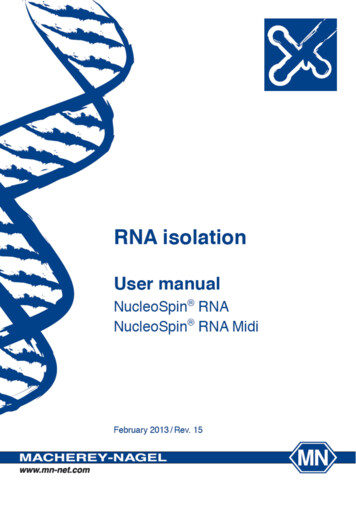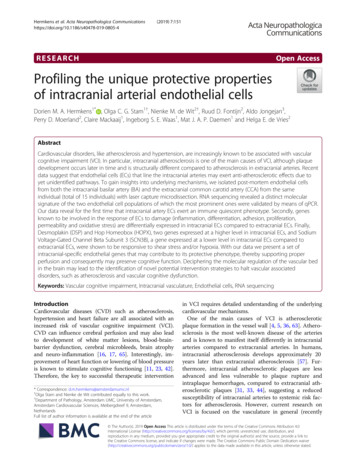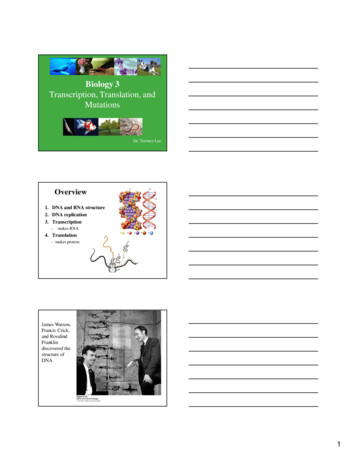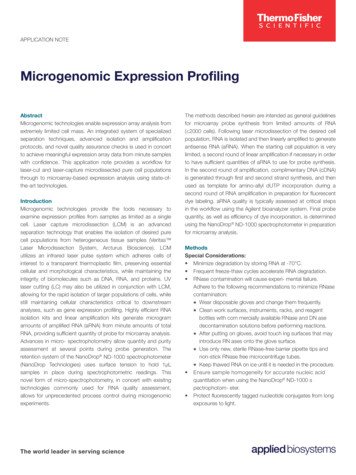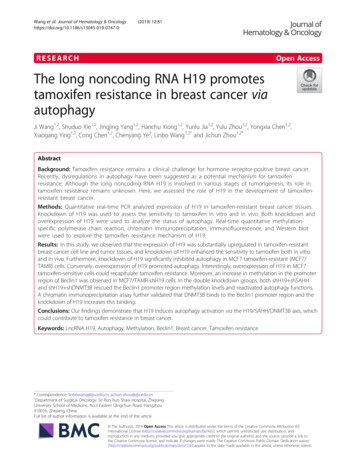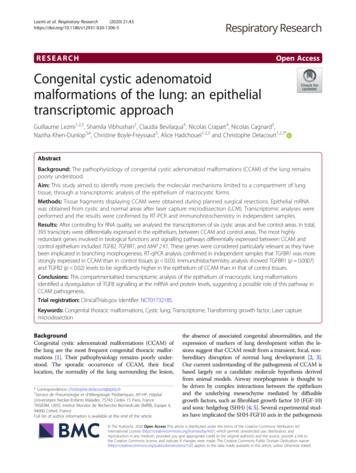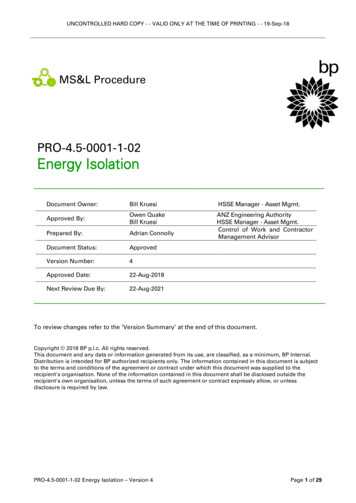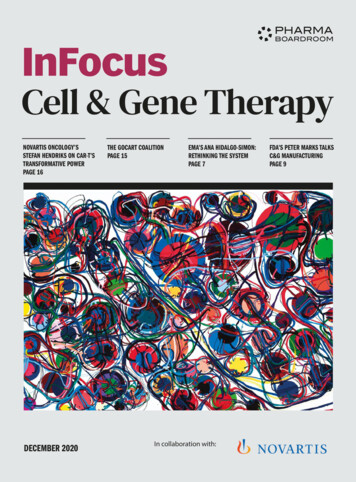
Transcription
Mouse RiboPure -Blood RNA Isolation Kit(Part Number AM1951)ProtocolI.Introduction . . . . . . . . . . . . . . . . . . . . . . . . . . . . . . . . . . . . . . . . . . . . . . . . . . . . . . . 1A. Product DescriptionB. Procedure OverviewC. Kit Components and Storage ConditionsD. Additional Materials RequiredE. Related Products Available from Applied BiosystemsII.III.Mouse RiboPure-Blood Procedure . . . . . . . . . . . . . . . . . . . . . . . . . . . . . . . . . . . . 6A. Experimental SetupB. Sample Collection and Stabilization of RNAC. Cell Lysis and Initial RNA IsolationD. Final RNA PurificationAssessing RNA Yield and Integrity . . . . . . . . . . . . . . . . . . . . . . . . . . . . . . . . . . . 13A. RNA YieldB. RNA QualityIV.V.Troubleshooting . . . . . . . . . . . . . . . . . . . . . . . . . . . . . . . . . . . . . . . . . . . . . . . . . . 16A. Low RNA Yield/ RNA DegradationB. RNA Contains Residual Genomic DNAAppendix . . . . . . . . . . . . . . . . . . . . . . . . . . . . . . . . . . . . . . . . . . . . . . . . . . . . . . . . 18A. (Optional) DNase I TreatmentB. Quality ControlC. Safety Information
P/N 1951M Revision BFor research use only. Not for use in diagnostic procedures.Revision Date: August 29, 2008Information in this document is subject to change without notice. Applied Biosystems assumes no responsibility for any errors that may appear in this document.Applied Biosystems disclaims all warranties with respect to this document, expressed or implied, including butnot limited to those of merchantability or fitness for a particular purpose. In no event shall Applied Biosystemsbe liable, whether in contract, tort, warranty, or under any statute or on any other basis for special, incidental,indirect, punitive, multiple or consequential damages in connection with or arising from this document,including but not limited to the use thereof.Literature Citation: When describing a procedure for publication using this product, please refer to it as theMouse RiboPure -Blood RNA Isolation Kit.If a paper that cites one of Ambion’s products is published in a research journal, the author(s) may receive afree Ambion T-shirt by sending in the completed form at the back of this protocol, along with a copy of thepaper.Applied Biosystems is committed to delivering superior product quality and performance, supported by industry-leading global service and technical support teams. Warranty information forthe accompanying consumable product is available at www.ambion.com/info/warranty in “Limited Warrantyfor Consumables,” which is subject to the exclusions, conditions, exceptions, and limitations set forth underthe caption “EXCLUSIONS, CONDITIONS, EXCEPTIONS, AND LIMITATIONS” in the full warrantystatement. Please contact Applied Biosystems if you have any questions about our warranties or would likeinformation about post-warranty support.Warranty and Liability:Patents and Licensing Notifications: The Mouse RiboPure -Blood RNA Isolation Kit is covered by USand foreign patents pending. The RNAlater supplied in the kit is covered by US and foreign patens pendingand the following issued patents: US 6,204,375, US 6,528,641 and AU 7455,943.Trademarks: Applied Biosystems, AB (Design), Ambion, RNAlater, and RNaseZap are registered trademarks, and DNA-free, GLOBINclear, MessageAmp, mirVana and RiboPure, are trademarks of Applied Biosystems Inc. or its subsidiaries in the US and/or certain other countries. All other trademarks are the soleproperty of their respective owners. 2008 Ambion, Inc. All Rights Reserved.
IntroductionI.A.IntroductionProduct DescriptionThe Mouse RiboPure -Blood RNA Isolation Kit is designed to isolatehigh yields of high quality total RNA—optionally including smallRNAs such as microRNA (miRNA)—from mouse and rat whole blood.The kit is designed for processing 0.25–0.5 mL blood samples; withminor procedural modifications lower blood volumes can be used.Microcentrifuge tubes pre-loaded with RNAlater are included forimmediate stabilization of RNA profiles in the sample. The stabilizedsamples can be stored for up to 3 days at room temperature, or for prolonged periods at –20 C before RNA isolation.The RNA isolation method is based on lysis of the blood in a guanidinium-based solution, followed by phenol/chloroform extraction, andfinal purification using glass fiber filter technology.RNA can be isolated from whole blood in 35 min using the MouseRiboPure-Blood Kit. Typically, 30–55 μg of total RNA (includingmiRNA) is obtained from 0.5 mL mouse blood. (RNA yields frommouse blood are considerably higher than from human blood.) Yields ofRNA from rat blood are approximately 18–40 μg from 0.5 mL blood.RNA isolated using the Mouse RiboPure-Blood Kit is highly pure andcan be used for most downstream applications, including RT-PCR,qRT-PCR, and microarray analysis.B.Procedure OverviewSample collection and RNAstabilizationCollect a 0.25–0.5 mL sample of mouse or rat whole blood, by themethod of your choice, such as cardiac puncture, orbital or tail bleed, oraspiration from the chest cavity after severing the hepatic artery. Add thesample to a supplied microcentrifuge tube which is pre-loaded withRNAlater and mix thoroughly (Figure 1 on page 2). Samples in RNAlater are stable for up to 3 days at room temperature or 4 C, or for prolonged periods at or below –20 C.NOTEDo not add more than 0.5 mL of blood to the tube. Figure 3 on page 8 showsthe maximum fill-line on the pre-loaded tube of RNAlater.Cell lysis and initial RNAisolationCentrifuge and remove the supernatant, then lyse the sedimented bloodin Lysis Solution (guanidinium-based). Next, extract the lysate withacid phenol/chloroform to remove most of the hemoglobin and otherblood proteins.I.A. Product Description1
Mouse RiboPure -Blood RNA Isolation KitFigure 1. Mouse RiboPure -Blood RNA Isolation Procedure OverviewSample Collection and RNA Stabilization1. Collect blood samples using standard methods2. Place 0.5 mL blood into 2 mL tubes pre-loaded with RNAlater and mix3. Store for 3 days at room temp/4 C, or long-term at –20 C or belowCell Lysis and Initial RNA Isolation1. Centrifuge samples for 3 min and remove the supernatant2. Add Lysis Solution and vortex vigorously3. Transfer to a 15 mL tube and add 200 μL 3 M Sodium Acetate4. Add Lysis Solution to a total volume of 3.8 mL and mix thoroughly5. Extract with 1.5 mL Acid Phenol:Chloroform, and recover the aqueous phaseFinal RNA Purification1. Adjust the volume of the aqueous phase and add ethanol2. Check the appearance of the solution3. Pass the sample through a Filter Cartridge4. Wash filter with 750 μL Wash Solution 15. Wash filter with 2 x 750 μL Wash Solution 2/3 and dry for 1 min6. Elute RNA with 250 μL preheated Elution Solution or Nuclease-free Water2I.B.Procedure Overview
IntroductionRNA in the recovered aqueous phase is further purified using a glassfiber filtering procedure. For recovery of total RNA which includesmiRNA and other small RNAs, the aqueous phase is diluted withNuclease-free Water, adjusted with ethanol, and filtered through theglass fiber Filter Cartridge provided. Users who don’t require smallRNA recovery can skip the dilution step and filter with a smaller overallvolume. We recommend using a vacuum filtration apparatus to filterthe relatively large preparation volumes, but they can alternatively beprocessed by multiple centrifugation passes into microcentrifuge tubes.Final RNA purificationThe RNA bound to the glass fiber filter is washed three times and theneluted with 80 C Elution Solution. Typical recovery of RNA is shownin Figure 2.A/JFA/JMBalbFBa b*lbFaC3HFC3HMC57FC57MDBAFDBAMNODNO F*DMNO aDMSJ bLFaSJLFbSJ *LMSWRMSW a*RM12 b*9F129MFor 0.25 mL blood samples, use reduced volumes of RNAlater, LysisSolution, Acid Phenol/Chloroform, and Elution Solution as describedthroughout the procedure.Genomic DNA28S rRNA18S rRNASmall RNAFigure 2. RNA isolated using the Mouse RiboPure -Blood RNA Isolation KitTotal RNA, including miRNA and other small RNAs, was isolated from 0.5 mL blood samples frommice of the indicated inbred strains using the Mouse RiboPure-Blood Kit. Blood was collected at TheJackson Laboratory and mixed with RNAlater , then shipped to Ambion at ambient temperature andstored at –20 C until processing. Samples were not treated with DNase. An aliquot ( 5%) of theeluted RNA was run on a denaturing agarose gel. The SWR Mb sample was processed for total RNAdepleted of small RNA, and was eluted in 125 μL instead of 250 μL. RNA samples marked with * wereextracted from 0.2–0.3 mL blood.Optional treatments ofpurified RNATrace levels of genomic DNA can be removed by DNase treatment; werecommend using the Ambion DNA-free Kit (P/N AM1906).Since the RNA is obtained from whole blood, it contains high levels ofglobin mRNA, which can compromise sensitivity for microarray detection. Globin mRNA levels can be reduced 95% by treating the elutedRNA with Ambion GLOBINclear –Mouse/Rat Kit (P/N AM1981),which uses a subtractive hybridization method to deplete alpha- andbeta-globin mRNAs.I.B. Procedure Overview3
Mouse RiboPure -Blood RNA Isolation KitC.Kit Components and Storage ConditionsThe Mouse RiboPure-Blood Kit contains reagents to isolate RNA from25, 0.5 mL whole blood samples from mouse or rat.AmountComponentStorage2 x 25 mL Acid-Phenol:Chloroform*4 C6 mL 3M Sodium Acetate pH 5.54 C or room temp25 mL Wash Solution 1 Concentrate(add 17.5 mL 100% ethanol before use)4 C or room temp45 mL Wash Solution 2/3 Concentrate(add 36 mL 100% ethanol before use)4 C or room temp25 x 1.3 mL 2 mL tubes pre-loaded with RNAlater100 mL Lysis Solution†252 x 25room temproom tempFilter Cartridgesroom tempCollection Tubesroom temp2 x 50 mL Nuclease-free Water10 mL Elution Solution (0.1 mM EDTA)any temp‡any temp‡* This reagent contains phenol, which is a poison and an irritant. Use gloves andother personal protection equipment when working with this reagent.† These components contain guanidinium thiocyanate, a potentially hazardous substance; use with appropriate caution.‡ Store at –20 C, 4 C, or room tempD.Additional Materials RequiredReagents and materials 100% ethanol, ACS grade or equivalent purity 15 mL conical plastic centrifuge tubes, nuclease-free, with volumemarks (e.g., P/N AM12500) Nuclease-free pipet tips, 200 μL (e.g., P/N AM12655) and 1 mL(e.g., P/N AM12665) 5 mL and/or 10 mL pipettes and pipetting tool 2 mL nuclease-free microcentrifuge tubes (e.g, P/N AM12425)Equipment Microcentrifuge capable of attaining 15,000 x g Table-top (clinical) centrifuge with rotor for 15 mL tubes, capable ofattaining 2,000 x g (e.g., IEC or Straight 8) Heat block for 2 mL tubes (Optional but recommended) Vacuum manifold and pump (suggested: Athena Technologies vacuum manifold item #4012) (Optional but recommended) 5 mL syringe (e.g., BD ref 309603)with plunger removed, to hold Filter Cartridges for vacuum filtration4I.C.Kit Components and Storage Conditions
IntroductionE.Related Products Available from Applied BiosystemsRNaseZap SolutionP/N AM9780, AM9782, AM9784RNA 6000 LadderP/N AM7152GLOBINclear -Mouse/RatWhole Blood GlobinReduction KitP/N AM1981DNA-free ReagentsP/N AM1906MessageAmp aRNAAmplification Kitssee our web or print catalogmirVana qRT-PCR PrimerSets and qRT-PCR miRNADetection KitP/N AM1558 and see web or printcatalogTURBO DNA-free KitP/N AM1907RNaseZap RNase Decontamination Solution is simply sprayed, poured, orwiped onto surfaces to instantly inactivate RNases. Rinsing twice with distilled water will eliminate all traces of RNase and RNaseZap Solution.The RNA 6000 Ladder is a set of 6 RNA transcripts designed for use as reference standards with the RNA 6000 Lab Chip Kits and the Agilent 2100 bioanalyzer.The GLOBINclear-Mouse/Rat Whole Blood Globin Reduction Kit employsa novel, non-enzymatic technology to remove 95% of the globin mRNAfrom whole blood total RNA samples from mouse or rat. The resultingmRNA is a superior template for RNA amplification and synthesis of labeledcDNA for array analysis.DNase treatment and removal reagents. This product contains Ambionultra-high quality RNase-free DNase I and reaction buffer for degradingDNA. It is ideal for removing contaminating DNA from RNA preparations.A novel reagent for removing the DNase without the hassles or hazards ofphenol extraction or alcohol precipitation is also included.Ambion offers a full line of MessageAmp Kits tailored for different array analysis applications. The MessageAmp II Kit offers maximum flexibility; samplescan be amplified using either single- or double-round amplification, and thereagent cocktails are configured to accommodate modification. For arraysrequiring biotin-labeled samples, Ambion offers the MessageAmp Premierand MessageAmp III RNA Amplification Kit. For preparation of fluorescently-labeled samples, we recommend the Amino Allyl MessageAmp II Kitswhich are available with and without Cy 3 and Cy5. Bacterial RNA can beamplified using the MessageAmp II Bacteria RNA Amplification Kit. We alsooffer the MessageAmp II-96 and Amino Allyl MessageAmp II-96 aRNAAmplification Kits for high throughput applications.The mirVana qRT-PCR Primer Sets and qRT-PCR miRNA Detection Kitprovide a novel detection system for specific small RNAs. Each qRT-PCRPrimer Set includes a primer for reverse transcription and a PCR primer pairoptimized for sensitive detection of specific miRNAs by qRT-PCR. mirVanaqRT-PCR Primer Sets are available for a comprehensive selection of thehuman, mouse, and rat miRNAs in the miRNA Registry, as well as forAmbion’s exclusive ambi-miRs. The qRT-PCR miRNA Detection Kit provides reagents for amplification of the miRNA targeted by the qRT-PCRPrimer Set via traditional endpoint RT-PCR or real-time RT-PCR usingSYBR Green I, and a control primer set.The TURBO DNA-free Kit is ideal for removing contaminating DNA fromRNA preparations. The kit employs Ambion TURBO DNase (patent pending), a specifically engineered hyperactive DNase that exhibits up to 350%greater catalytic efficiency than wild type DNase I. It also includes a novelreagent for removing the DNase without the hassles or hazards of phenolextraction or alcohol precipitation—and without heat inactivation, which cancause RNA degradation.I.E. Related Products Available from Applied Biosystems5
Mouse RiboPure -Blood RNA Isolation KitII.A.Mouse RiboPure-Blood ProcedureExperimental SetupRNase precautionsLab bench and pipettorsBefore working with RNA, it is always a good idea to clean the labbench and pipettors with an RNase decontamination solution (e.g.,Ambion RNaseZap Solution, P/N AM9780).Gloves and RNase-free techniqueWear laboratory gloves at all times during this procedure and changethem frequently. Gloves protect you from the reagents, and they protectthe RNA from nucleases that are present on skin.Use RNase-free pipette tips to handle Wash Solutions and Elution Solution, and avoid putting used tips into the kit reagents.Use the Collection Tubes supplied with the kit; they have been testedfor RNase contamination and are certified RNase-free.Prepare Wash Solution 1and Wash Solution 2/3a. Add 17.5 mL 100% ethanol to the Wash Solution 1 Concentrate.b. Add 36 mL 100% ethanol to the Wash Solution 2/3 Concentrate.c. Mix both solutions well, mark the labels to indicate that the solutionsare completed, and store at room temperature.The completed solutions are called Wash Solution 1 and WashSolution 2/3 in these instructions.Blood samples 0.25 mLFor 0.25 mL blood samples, modify the volumes of reagents asdescribed in the procedure.(Optional) Set up for vacuumfiltrationTo set up for vacuum filtrationRemove the plunger of a 5 mL syringe, and attach the barrel to the inletport of the vacuum manifold.Choose vacuum filtration or centrifugation for the glass fiberfiltration stepIn step D.1 on page 10, there are different procedures for recoveringeither total RNA with the small RNA component (e.g., miRNA) ortotal RNA depleted of small RNAs. The volume of solution to be passedthrough the Filter Cartridges in the final RNA purification will differdepending on the procedure chosen; consider the preparation volumewhen deciding whether to use centrifugation or vacuum filtration.For recovery of total RNA, including small RNAs such as miRNA:the sample volume is 13–15 mLFor recovery of total RNA depleted of small RNAs such as miRNA:the sample volume is 5.5–6.5 mL6II.A.Experimental Setup
Mouse RiboPure-Blood Procedure Filtration using a microcentrifuge requires several successive centrifugations ( 8 times for samples that are small-RNA–depleted, 18times for samples that include small RNAs), but requires no otheradditional equipment. Vacuum filtration allows continuous application of the sample to theFilter Cartridge and is easier when processing larger volumes, butrequires a vacuum manifold and pump.Assemble and labelplasticware for the final RNApurification Briefly inspect the Filter Cartridges before use. Rarely, the glass-fiberfilters may become dislodged during shipping. If this is the case, gently push the filter down to the bottom of the cartridge using the wideend of an RNase-free pipet tip. For each sample, place a Filter Cartridge into a 2 mL CollectionTube. Label the lid of the resulting Filter Cartridge assembly. Label a second Collection Tube for elution and storage of each sample.Preheat Elution Solution to80 CAt the end of the this procedure, RNA can be eluted in either the Elution Solution provided with the kit or in Nuclease-free Water. ElutionSolution is nuclease-free 0.1 mM EDTA, if this could interfere withyour application, elute in Nuclease-free Water instead.In an 80 C heat block, preheat at least 250 μL of Elution Solution orNuclease-free Water per sample, plus 5% overage, in a tightly closednuclease-free 2 mL microcentrifuge tube (not provided).B.Sample Collection and Stabilization of RNA1. Collect blood samplesusing standard methodsCollect mouse or rat blood samples using standard methods (e.g., cardiac puncture, orbital or tail bleed, aspiration from chest cavity aftersevering hepatic artery, etc.). Anticoagulant is not necessary if blood is collected into an airtightcontainer (e.g., a syringe). To collect blood into non-airtight containers, use an anticoagulant.EDTA is preferred, because heparin has been reported to inhibitRT-PCR. (Note that our scientists have not observed such inhibition.)II.B. Sample Collection and Stabilization of RNA7
Mouse RiboPure -Blood RNA Isolation Kit2. Place 0.5 mL blood into2 mL tubes pre-loadedwith RNAlater and mixMaximum Fill LineRNAlater Figure 3. Blood sample filllevel in the pre-loaded 2 mLtube.3. Store for 3 days at roomtemp/4 C, or long-term at–20 C or belowC.a. Place 0.5 mL blood into the 2 mL tubes pre-loaded with RNAlater(provided). Figure 3 (left) shows the maximum fill line on the tubefor adding the blood sample to the RNAlater.IMPORTANTThe amount of RNAlater in the pre-loaded tubes is designed to accommodate no more than 0.5 mL of blood. It is not necessary to determine theexact volume of blood added to the tube, but avoid overfilling the tubes.The ring between the vertical ridges and the collar at the top of the tubemarks the maximum fill level when adding blood sample to the tube.For 0.25 mL blood: Remove and discard 650 μL of the RNAlaterfrom the pre-loaded 2 mL tube provided. Then add the blood sample to the remaining RNAlater in the tube.b. Mix the sample thoroughly by inverting the tube several times. Store 3 days at room temperature or 4 C. Store long-term at –20 C or below.Cell Lysis and Initial RNA Isolation1. Centrifuge samples for3 min and remove thesupernatantFor frozen samples: thaw at room temperature. Vortex or shake thetube briefly to disperse its contents.a. Centrifuge samples for 3 min at maximum speed( 15,000 x g) in a microcentrifuge.The blood cells and plasma proteins will form a large brown or reddish-brown pellet which may smear upward along the side of thetube. The supernatant is typically turbid, and may be pale pink,brown, or colorless.b. Remove and discard the supernatant by aspiration orpouring. Thoroughly remove all of the fluid, even if it is pigmented and/orviscous. Remove even the supernatant directly above the cell pellet,which may be more turbid, and which may contain some white particulate matter. Note: this material is not the “buffy coat” fractionseen in untreated whole blood after centrifugation. If the supernatant was poured off, tap the rim of the inverted tubegently against a paper towel to remove all residual fluid. Remove any fluid from inside the tube cap. The volume of the blood pellet after removing the RNAlater shouldbe approximately the same as the starting volume of blood added tothe tube. If the pellet is significantly larger than this, it is an indication that the separation of RNAlater from the blood was incomplete.8II.C.Cell Lysis and Initial RNA Isolation
Mouse RiboPure-Blood ProcedureProceed with the procedure, but be sure to inspect the sample closelyas described in step D.2 on page 11. (See also Inefficient separation ofRNAlater from blood on page 16.)2. Add Lysis Solution andvortex vigorouslya. Add Lysis Solution to the blood pellet to almost fill the 2 mL tube,leaving sufficient space in the tube to permit thorough mixing.b. Vortex vigorously to resuspend the blood pellet and lyse the bloodcells. Invert the tube and observe to make sure the sample iscompletely dislodged.3. Transfer to a 15 mL tubeand add 200 μL3 M Sodium Acetatea. Pour the lysed blood sample into a 15 mL conical tube.4. Add Lysis Solution to atotal volume of 3.8 mLand mix thoroughlya. Use the volume marks on the 15 mL tube to measure the preparationvolume, and determine how much additional Lysis Solution is neededto bring the volume to a total of 3.8 mL.For 0.25 mL starting blood volume: plan for a total of 2 mL.b. Add 200 μL 3 M Sodium Acetate and mix well. Some undissolvedclots may be visible at this step.For 0.25 mL starting blood volume: add 100 μL 3 M Sodium Acetate and mix well.b. Rinse the 2 mL tube with a portion of the additional Lysis Solutionneeded and pool this with the lysate in the 15 mL tube.c. Add more Lysis Solution, if necessary, to bring the volume to a totalof 3.8 mL.For 0.25 mL starting blood volume: Add Lysis Solution to bringthe total volume to 2 mL.d. Mix thoroughly by vortexing for 5 sec. The lysate should now behomogeneous with no undissolved clots. Invert the tube and observeit to be sure the solution is homogenous.5. Extract with 1.5 mL AcidPhenol:Chloroform, andrecover the aqueousphasea. Withdraw 1.5 mL of Acid-Phenol:Chloroform from beneath theoverlying layer of aqueous buffer, add it to the cell lysate, close thetube tightly and shake vigorously for 30 sec.For 0.25 mL starting blood volume: Use only 800 μL Acid-Phenol:Chloroform.b. Store for 5 min at room temperature.c. Centrifuge for 10 min at 2,000 x g ( 3,200 rpm in a table-topcentrifuge) to separate the aqueous and organic phases.The aqueous (upper) phase should be clear and well-separated, witha thin interface.d. Recover the aqueous (upper) phase in a fresh 15 mL tube. Discard theorganic phase.II.C. Cell Lysis and Initial RNA Isolation9
Mouse RiboPure -Blood RNA Isolation KitNOTEThe typical volume of the aqueous phase is 3.6–4 mL. Do not recovermore than 4.2 mL of aqueous phase or the capacity of the 15 mL tube willbe exceeded in the next step if you are using the procedure for recoveryof total RNA including small RNAs).STOPPING POINTIf desired, samples may be stored at –20 C for later processing.Samples that will be processed for recovery of total RNA that is depletedof small RNAs may be stored before or after adding the water and ethanol(described below).Store samples that will be processed for recovery of total RNA includingsmall RNAs before adding the water and ethanol to avoid compromisingrecovery of small RNAs.Warm stored samples to room temp and mix well by vortexing before filtration (described in step 3 on page 11).D.Final RNA Purification1. Adjust the volume of theaqueous phase and addethanolThere are slightly different instructions to prepare the semi-purifiedRNA for purification using a glass fiber filter procedure. Follow eitherstep 1a or step 1b below depending on whether you want to obtain totalRNA that includes, or is depleted of, the small RNA fraction.1a. For recovery of totalRNA, including smallRNAs such as miRNAs:a. Add 0.6 volume Nuclease-free Water to the aqueous phase.For example, if 4 mL of aqueous phase was recovered in step C.5,add 2.4 mL (4 mL x 0.6) of Nuclease-free Water. The solution typically becomes turbid upon addition of the water.b. Mix thoroughly by vortexing for 5 sec.The solution usually clears after mixing.c. Add 1.2 volumes of 100% ethanol, and vortex for 10 sec oruntil the preparation clears.Add 1.2 volumes of 100% ethanol relative to the current prep volume.Using the same example, add 7.7 mL of ethanol (1.2 x [4 2.4]).Use the markings on the 15 mL tube to measure the volume of thediluted aqueous phase. The volume of a preparation from a 0.5 mLblood sample after this step should be 13–15 mL.1b. For recovery of totalRNA that is depleted ofsmall RNAs:a. Add 0.5 volume 100% ethanol to the aqueous phase.For example, if 4 mL of aqueous phase was recovered in step C.5,add 2 mL (4 mL x 0.5) of 100% ethanol. The solution typicallybecomes turbid upon addition of the 100% ethanol.b. Mix thoroughly by vortexing for 10 sec.Observe the solution to ensure that it is homogeneous; if refractivepatterns are present, vortex 5 sec longer.10II.D.Final RNA Purification
Mouse RiboPure-Blood Procedure2. Check the appearance ofthe solutionRarely, the preparation does not clear, or precipitation or secondary phaseseparation at the bottom of the tube is observed. If this happens, addNuclease-free Water in 300 μL increments and vortex until the mixture ishomogeneous and essentially clear (slight turbidity is acceptable).STOPPING POINTIf desired, the prep may be partially filtered as described in the next step andthe remainder saved at –20 C for later processing. Warm stored samples toroom temp and mix well by vortexing before filtration.3. Pass the sample througha Filter CartridgeFor vacuum filtration:a. Place a Filter Cartridge in the barrel of a 5 mL syringe attached to aninlet port of the vacuum manifold.b. Using the vacuum, pass the sample through the filter.For microcentrifuge filtration: Pass the sample through the Filter Cartridge by centrifuging 700 μL of sample at a time.a. Apply 700 μL of the sample to a Filter Cartridge assembly, close thelid, and centrifuge for 10 sec in a microcentrifuge set to at least8,000 x g to pass the liquid through the filter. Discard theflow-through from the Collection Tube, and replace the FilterCartridge in the same Collection Tube.b. Load the next 700 μL of sample onto the filter. Centrifuge as beforeto pass the sample through the filter and discard the flow-through.Repeat to filter the remaining sample.4. Wash filter with 750 μLWash Solution 1For samples filtered using vacuum filtration: Transfer the Filter Cartridge to a labeled Collection Tube.For all samples: Apply 750 μL Wash Solution 1 to the assembly andcentrifuge for 5–10 sec in a microcentrifuge set to maximum speed topass the solution through the filter. Discard the flow-through from theCollection Tube, and replace the Filter Cartridge in the same CollectionTube.5. Wash filter with2 x 750 μL WashSolution 2/3 and dry for1 mina. Apply 750 μL Wash Solution 2/3 to the Filter Cartridge assemblyand centrifuge for 5–10 sec to pass the solution through the filter.Discard the flow-through from the Collection Tube, and replace theFilter Cartridge in the same Collection Tube.b. Repeat step a with a second 750 μL aliquot of Wash Solution 2/3.c. Spin the Filter Cartridge assembly for 1 min at maximum speed toremove residual fluid from the filter.II.D. Final RNA Purification11
Mouse RiboPure -Blood RNA Isolation Kit6. Elute RNA with 250 μLpreheated ElutionSolution or Nuclease-freeWatera. Centrifuge the tube of preheated (80 C) Elution Solution orNuclease-free Water briefly to remove condensation from the sidesand top of the tube.b. Transfer the Filter Cartridge into a new labeled Collection Tube.Apply 250 μL preheated Elution Solution or Nuclease-free Water tothe center of the filter, and close the cap.For 0.25 mL starting blood volume: use 150 μL Elution Solutionor Nuclease-free Water.NOTEThe exact volume of solution used to elute the RNA may be adjustedaccording to the desired RNA concentration. The RNA can be eluted in alower volume to increase concentration; however, eluting in less than150 μL may not provide thorough RNA recovery.c. Leave the assembly at room temperature for 1 min.d. Centrifuge the Filter Cartridge Assembly for 1 min at maximumspeed to recover all of the eluted RNA in the Collection Tube.Discard the Filter Cartridge.e. Store the RNA at –20 C or below.12II.D.Final RNA Purification
Assessing RNA Yield and IntegrityIII.A.Assessing RNA Yield and IntegrityRNA YieldExpected RNA yieldThe expected RNA yield is 30–55 μg from 0.5 mL of mouse blood.Yield from rat blood is more variable and ranges from 18–40 μg per0.5 mL of blood.SpectrophotometryThe concentration of an RNA solution can be determined by measuringits absorbance at 260 nm (A260). The NanoDrop 1000A Spectrophotometer is extremely quick and easy to use; measure 1–2 μL of the RNAsample directly, following the manufacturer’s instructions.Alternatively, the RNA concentration can be determined by diluting analiquot of the preparation in TE (10 mM Tris-HCl, pH 8,1 mM EDTA) and reading the absorbance in a traditional spectrophotometer at 260 nm. To determine the RNA concentration in μg/mL,multiply the A260 by the dilution factor and the extinction coefficient(1 A260 40 μg RNA/mL).A260 X dilution factor X 40 μg RNA/mLNote
longed periods at -20 C before RNA isolation. The RNA isolation method is based on lysis of the blood in a guanidin-ium-based solution, followed by phenol/chloroform extraction, and final purification using glass fiber filter technology. RNA can be isolated from whole blood in 35 min using the Mouse RiboPure-Blood Kit. Typically, 30-55 .
